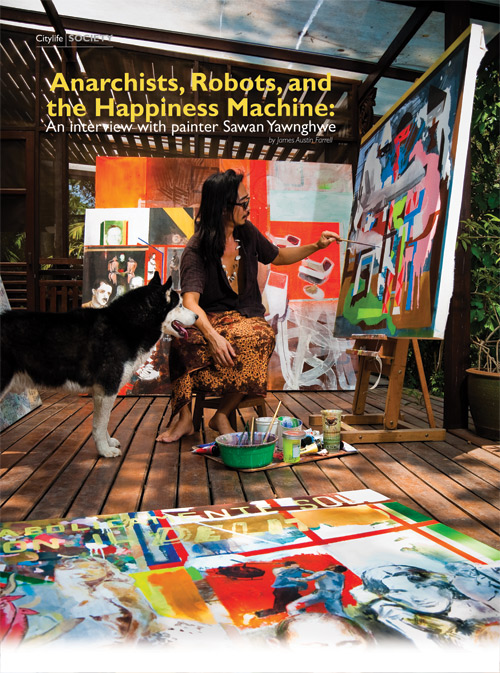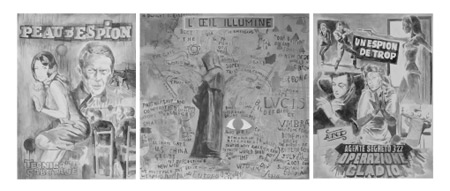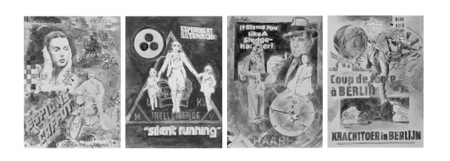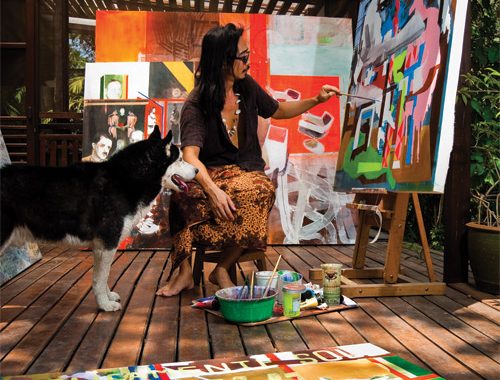
Sawan Yawnghwe was born in 1971 deep in the jungles of Burma, surrounded by the Shan State Army which was engaged in its bitter war against the Burmese military junta. Later in life he became a painter; scaling the hallowed, and by his own admission, sometimes hollow heights of the Euro-art scene, only to end up back where he started, here in little old Chiang Mai, his childhood home.
Despite his being back on home turf Sawan refers to himself as an ‘outsider’, though not really in terms of geography, rather due to his assiduous scepticism of most things conventional. As an artist, as a person, his focus these days is set on unveiling the truth about the collective work of art that is contemporary society; to wipe the surface, even deface, the storyboard of society with a caustic brush, in order to see what lies beneath. He has become, in one respect, a critic of modern culture, of politics, of many of the things that drive us to get out of bed in the morning. His criticisms are neither flared, or even that impassioned, instead he embodies a kind of feline languidness, a ‘hipster’ lethargy, and between each thoughtful response to a question he might take up to ten minutes in repose, rolling a cigarette, or some other act of dalliance. And then, as if charged to wax lyrical, he lets the proverbial, in this case verbal, cat out of the bag.
Politics and philosophy run deep through Sawan’s family tree. His grandfather, Sao Shwe Thaik, the last Saopha (Shan for king or chieftain) of Yawnghwe, was also the first President of the Union of Burma after the country gained its independence from the English. He was arrested after the military coup in 1962 and was later assassinated. His grandmother, Sao Yawnghwe was a staunch advocate of human rights, social equality and democracy in Burma, and is still widely revered by the Shan people for her democratic convictions. Chao Tzang Yawnghwe, the father of Sawan, was both a political scientist and SSA (Shan State Army) officer. Chao Tzang wrote it was his “duty to fight for the Shan people” against those he called “ethnic-chauvinists”, the “cancer” of military rule. He fought in the war against the military into the ’70s, when inherent dangers forced him to flee Burma, taking his wife, Nunu, and a one year old Sawan, to Chiang Mai. After surviving two assassination attempts here in the Lanna capital he decided to move his family to Canada. He died in 2004.
Sawan lived in Chiang Mai up until the early eighties until he was twelve, and before leaving to Vancouver had become fluent in Thai and very much a local, though he says, “I was always aware I was Shan, that I was Tai Yai, as the Thais say.” He explains that in spite of his family’s nobility, he never exactly engendered the exalted status of a prince, a lofty position that he says is merely fact “in terms of bloodline”.

“I felt double removed in Canada, I grew up like everyone else, taking the bus to school, living in an apartment; I didn’t grow up as a prince.” It was in Canada where he found his appreciation of art. He also studied philosophy at Concordia University in Montreal to give himself a more “complete knowledge” that was lacking in the art milieu.
After graduating in 1993 he moved to Italy, having accepted an invitation from a friend and it was there that Sawan began to paint prolifically. He started Dormice, with fellow artist Heinrich Nicolaus, and worked from a studio in Tuscany where they became co-creators of each painting, Sawan painting the figures, and Nicolaus painting the backgrounds. “We became relatively successful,” admits Sawan, though ‘relatively’ might be an understatement considering his paintings are sold for hefty prices in the tens of thousands of dollars, at auction houses around the world, including Christies, and have been bought by the likes of Leonardo Di Caprio. They were also accredited with being part of the ‘100 best things in the world’ by GQ magazine in 2008. He says of his modicum of fame: “The fact the art was able to sell made me not want to sell it, I doubted the legitimacy of it somehow. You realise what you have to do to make a painting sell, it doesn’t mean you are any better. You need a good agent, you need to know the market and you need a good story. If I painted explosions, the art sold – people loved explosions. I used propaganda and certain symbols. A painting would sell immediately if I added a clever line from Nietzsche to it.”
In spite of his fame, his art-star status, he began to feel very much dissatisfied. “I had the first Blackberry, Prada clothes, but it didn’t change my life. It was a waste of money. It was all wrong, the good life. I wasn’t getting much out of it.” This was not a decision that rallied against money per se, or bourgeois guilt, he says he just became disenchanted with his “Starbucks lifestyle”. Nowadays he lives in a bucolic part of Chiang Mai at a friend’s house surrounded by bugs, dogs and fruit trees. ‘Lo-So’ staple blue flip flops have replaced the Prada and he’s not one for talking on mobile phones.
He left Italy and went to Rishikesh, India, in 2007 where he compiled pen and ink sketches for a book called ‘The Disasters of Military Rule in Burma’, a book that would detail the wickedness and ineptitude of military rule. “I wanted to view the victim as a hero in this book, turn it around,” he says, adding that he took inspiration from Goya’s ‘Disasters of War’ in painting the allegories.
Automatic People
Sawan is raucously sceptical of western democracy. “What is democracy,” he asks, “is it manufactured or engineered? Does it really exist in the west? If you question your government’s fight against Islam in the US

you are branded a terrorist. It’s a paranoid schizophrenic state of mind. We are stuck in the mechanism, ‘are you with us or against us?'” He has a muscular distrust of the ‘dark powers’ that lead us; he is also convinced there exists ‘underground organisations’ where evil men make evil plans. His motto, I think, is trust no one . . . but yourself. His upcoming exhibition at Sangdee Gallery in Chiang Mai, illustrates this point.
He talks about the emancipation of the individual versus the sheepish soul that is bound in the collective mulch of society. “When you get into collective polemics, it’s a problem,” he says, accepting that it’s not an easy road to walk if you are to adhere to the precepts of stony individualism, after all, we are a society that is based on collective principles. We are led on a merry dance, told what to buy, what to eat, how to be happy. Marketing is based on a collective principle. We are sheeple, as Edward Bernays – a character Sawan is fond of mentioning – rightly knew (Bernays was the founding father of PR who used his uncle Sigmund Freud’s subconscious axioms to manipulate public opinion on such things as our taste in clothes, our bad habits, and even world leaders).
“All the stuff we’ve been taught has somehow been manipulated. It’s not truth . . . What is drilled into us in kindergarten for God’s sake? ‘Do what you’re told!’ Even in academia the topics are chosen for us.” Not much escapes his scepticism, not least the mass media, who he says is so often in the pockets of the elite, or merely disseminates news that is rehashed rather than rigidly researched. The individual perspective is more important than ever he says, adding that at least the internet is a place where the individual mind can be found writing on blogs, etc. “Engineered consent is what they work on in the media, they work on our subconscious fears. He mentions the word ‘automaton’, a word Henry Miller was fond of using when lambasting the American herd mentality in the 50s. “Really, the individual doesn’t stand a chance. Mass media is genius, you can’t fight it, it’s a modern phenomenon.”

Survival of the Dumbest
Imagine fluoride in your toothpaste to make you passive, bovine, submissive. Imagine the Twin Towers disaster a US political stratagem. Imagine a volcanic eruption engineered by a round table of megalomaniacal men with million dollar minds. We are part of the machine that ‘they’ control, and ‘they’ are an invisible enemy. He talks animatedly about mass consumerism, mass marketing, the happiness machine that is created for us by our not so benevolent leaders and captains of industry. “This is Plato’s Republic. If you run a country, you have to run a tight ship!” He maintains we must see through the noble lies we are fed, and despite the seemingly congenital herd mentality we’ve inherited, we must arm ourselves (metaphorically) and “be responsible for ourselves.” The system he says, of liberal democracy, might work, if it weren’t so corrupt, if it “were applied correctly”. But the problem is, it is not, the system “runs like a wild fire”. We, the people, he alludes, are the natural defence to this omnipresent conflagration.
“I don’t know if this [control of the masses] is a decision of some people or if it’s just organic. Is all this stuff just natural progression? Is it intrinsic, collectivism, is it part of the human evolution? Is it Darwinian, alone the human can’t survive? Maybe we’re hardwired for groups, we are collective for survival. It’s hard to be an individual; it goes against your intuition.” He talks about the concept of having a partner, of needing to have a partner, or eventually getting married, as if it’s a kind of sexual bondage. Men or women deciding not to marry and spending time alone have a hard time of it, they become ‘antiheroes’ of society. “The individual life ends bad, we are told the individual is not to be trusted . . . do as your friends do.”
“We should work on ourselves individualistically while maint
aining the group dynamic, take responsibility and be a free person. Theoretically this should be protection against corruption. One must be sceptical. I am sceptical about everything. I know I have been brainwashed . . . I questioned my own life, I had to, I felt I was blind.”
Sawan, along with fellow artist Sondenkind, will exhibit their collaborative art – ‘New Paintings’ – at Sangdee Gallery on Sirimankalajarn Soi 5 from May 20th – Sept 16th. Their works draw heavily on spy aesthetics of the post-war era, film noir posters, exploiting propaganda and PR techniques developed for mass mind control and the engineering of consumer behaviour, mixed with occult symbolism, quotes, weaslewords and fragmented metaphors.
Opening Reception May 22nd
